 HCH 17 / July 2017
HCH 17 / July 2017
The Warsaw Ghetto: A Narrative and Reflection, by Jared Sorhaindo
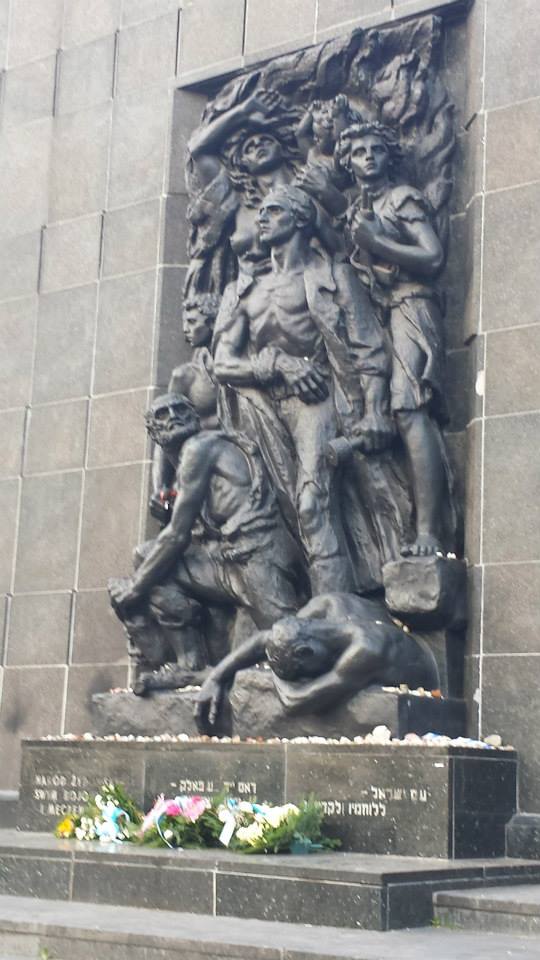
(The Monument to the Ghetto Heroes in Warsaw, Jared Sorhaindo, September 2014)
It was May 1943 and the Warsaw ghetto, the largest ghetto of Nazi-occupied Europe, lay in smoldering ruins. Warsaw’s Grand Synagogue, which had dominated Tłomackie Street, was nothing but a pile of bricks, its demolition personally carried out by SS General Jürgen Stroop. What had once been a densely-populated area, a cacophony of voices of Jews of all sorts – secularists, socialists, Zionists, Orthodox, men, women, children – was now quiet as the tomb. The rest of Warsaw would join it in the autumn of 1944, when the Germans systematically obliterated the city during and after the Polish uprising.
How had it come to this? How had the Warsaw ghetto fit into Nazi policy and intentions? What had life been like in the ghetto? Why had it been destroyed? What were Polish reactions to the ghetto and its destruction?
The Establishment of the Ghetto
After the fall of Warsaw to German forces in September 1939, the Nazis, who were driven by a fanatical anti-Semitism, were faced with a dilemma: what to do with the city’s Jews? The Jewish population of Warsaw was the largest urban center of European Jewry and the second largest in the world after New York. One-third of the people residing in Poland’s capital was Jewish.
While Nazi policy in the Reich (Germany, Austria, and the Czech lands) had been to expel the Jews under their rule, this became orders of magnitude more difficult once Germany had occupied Poland, the center of world Jewry. Old methods of forced emigration were not possible. The Germans planned to send the Jews to a “reservation” in a swampy part of the Lublin district, then the easternmost part of the Nazi empire. There they would be decimated by impoverishment, starvation, and disease before being sent somewhere to the east as part of a “Final Solution.” When this did not work out for all sorts of logistical reasons, the Nazis considered deporting the Jews en masse to the island of Madagascar in the Indian Ocean. When this also did not pan out, due to British control over the necessary sea lanes, the Nazis in effect decided to keep the Jews penned up pending a future decision.
The Nazis immediately tried to isolate the Jews of Warsaw from their “Aryan” neighbors. According to their ideological reasoning, the Jewish community was a bastion of criminal elements, epidemics, and some kind of wizardry that would cast influence over the Poles. Therefore, the Jews had to be monitored and contained – the original conception was to ghettoize them in Praga, the part of Warsaw east of the Vistula River. Originally, the Polish municipality disagreed with establishing a Jewish ghetto, as the Jews were vital to Warsaw’s economy. The German military commander agreed, so plans for a ghetto were shelved.
Eventually, however, ideological considerations superseded economic and rational ones. The working neighborhood of Muranów, in central Warsaw, which was predominantly inhabited by Jews, was selected as the heart of the ghetto. Jews were forced into the specified area and Poles were forced out. In typical Nazi fashion, the ghetto was formally announced on Yom Kippur, the holiest day on the Jewish calendar. Thirty percent of the city’s population, in addition to more forced in from surrounding towns and villages, was crammed into 2.4% of its area. The ghetto was sealed on November 16, 1940, surrounded by a 10-foot-high wall.
Life in the Ghetto
From the very beginning, Nazi policymakers debated whether the Jews of the ghetto should be allowed to work for a living or if they should just be starved so they would die off. Proponents of Jewish labor won out – Jews would be forced to work for the German war industry. Contractors for the German Army set up shop in Warsaw to take advantage of Jewish labor.
Jewish life in the ghetto varied, but was generally miserable. The typhus epidemics that the Nazis feared became a self-fulfilling prophecy, as the Jews lived on top of one another in wretched conditions.The caloric intake allowed by the Nazis was literally a death sentence, so Jews needed smuggled food to live: many smugglers were small children whose families relied on their daring to survive – frequently, if the children were caught, they were shot on the spot. More complex smuggling networks, made up of adults, were also set up. Eventually, these smugglers became the elite of the ghetto, frequenting fancy restaurants and nightclubs. Nonetheless, the average inhabitant of the ghetto was fighting a daily struggle for survival. Nearly 100,000 Jews were to die from starvation and disease during the ghetto’s existence. Jewish inhabitants of the ghetto eventually became inured to the sight of emaciated bodies on the streets before they were dumped into anonymous mass graves in the Jewish cemetery on Okopowa Street.
The ghetto was administered by the Jewish Council, known in German as the Judenrat. A concept originally conceived by Reinhard Heydrich, the second-in-command of the SS, Judenräte were established in every ghetto, where they were to enact every German demand to the letter. The members of the Judenräte were in an impossible position. While sometimes doing everything they could to lessen the blow of German policies, even the best of them were usually considered to be nothing more than German lackeys. Warsaw’s Judenrat consisted of 24 individuals and was led by Adam Czerniaków, an engineer and native of Warsaw. It was responsible for budgeting, social welfare, taxation, and food distribution.
Another important body within the ghetto was the Jewish police. While at first they were a source of pride for the Jews, eventually they became deeply associated with the Germans’ policies of destruction, particularly the mass deportations from the ghetto beginning in the summer of 1942.
The Jews tried their best to cultivate cultural events in the ghetto. Plays and concerts were put on. There were poetry recitations and literary discussions. While Jewish communal prayer was expressly forbidden by German law, many ghetto inhabitants performed religious ceremonies clandestinely, which provided a desperately needed hope and strength to many. Jewish underground newspapers engaged in vociferous political debates between socialists, communists, Zionists from across the political spectrum, and the Orthodox. A group called Oyneg Shabbos, led by the historian Emmanuel Ringelblum, thoroughly documented everyday life in the ghetto and provided analyses of the current situation. Many, although not all, of the documents collected by this group were unearthed after the war, having been stashed in milk cans and buried.
Großaktion Warschau
On July 19, 1942, SS chief Heinrich Himmler ordered that the Jews of Nazi-occupied Poland were to be killed by the end of the year. Three days later, on the eve of Tisha B’Av (a fast day in Judaism commemorating the anniversary of the destruction of both Jerusalem temples), Adam Czerniaków was summoned to the office of Hermann Höfle, an SS deportation specialist normally based in Lublin. Czerniaków was told that 6,000 Jews were to report to an embarkation point known as the Umschlagplatz at 4:00 pm that day to be resettled. This would be repeated indefinitely. Czerniaków, knowing what this meant, committed suicide the next day.
What did it mean? In October 1941, Heinrich Himmler and his representative in Lublin, Odilo Globocnik, decided to build the Bełżec extermination camp, which was outfitted with homicidal gas chambers. Beginning in March 1942, Jews from the Lublin district were deported to Bełżec, where they were, almost without exception, gassed immediately. A sister camp, Sobibór, began operations in May. In July 1942, a third camp was ready.
This was Treblinka. Treblinka was located in a remote, heavily-forested region about 50 miles northeast of Warsaw. Like Bełżec and Sobibór, it was manned by former personnel of the “euthanasia” program, which had killed the mentally and physically handicapped, and approximately 100 Ukrainians. It was a pure death facility, unlike Auschwitz-Birkenau. One arrived in Treblinka, as at Bełżec and Sobibór (and Chełmno further west) for one reason and one reason only: to die.

(The memorial at Treblinka)
It was this abattoir that awaited the Jews of Warsaw. The 6,000 Jews demanded by Höfle were gassed the following morning. Between July and September 1942, at least 265,000 Jews were deported from Warsaw and killed at Treblinka. Among them was the prominent educator Janusz Korczak, who ran an orphanage in the ghetto. Although he was initially spared, the children under his care were not, and he insisted on boarding the train with them. The Jewish police and their families, initially spared as an incentive for them to assist the Nazis with the roundups, were sent on the final trains on September 12.
The Germans allowed 35,000 Jews to remain in the ghetto to continue working for the German war industry, this time under the direct auspices of the Gestapo. In reality, there were many more Jews in the ghetto – perhaps 20,000 – in an unofficial, unregistered capacity.
Resistance
Some of the more politically-minded Jews of the ghetto had considered resistance even before the deportations began. Members of the Jewish Labor Bund, who were socialists who saw themselves as part of the broader Polish underground and were fervent anti-Zionists, did not think it prudent to resist without the support of the Poles, which was decidedly not forthcoming. Many who had wanted to revolt were seen as hotheads.
A prevailing view was that any armed resistance by the Jews would lead to extreme violence against the residents of the ghetto. When the deportations actually began, many Jews told themselves that the deportees were being sent to labor camps and not to their deaths, as Nazi lies told them. Nevertheless, the Jewish Fighting Organization (Polish: Żydowska Organizacja Bojowa, or ŻOB) was formed during the first week of the deportations. The political tensions within the ŻOB, which was made up of a smattering of groups with different leanings, as well as the lack of arms and Polish support, prevented them from carrying out any acts of resistance. Another group of right-wing Zionists was formed as well – the Jewish Military Union (Polish: Żydowski Związek Wojskowy, or ŻZW). Both groups gathered “taxes” – sometimes at gunpoint – from ghetto inhabitants to finance the purchase of weapons from the Poles and embarked on a campaign of assassination and intimidation against members of the Jewish police and the Judenrat.
A young leader of the leftist HaShomer HaTzair Zionist group, Mordechaj Anielewicz, had been outside of Warsaw during the Aktion, trying to drum up Jewish resistance. Upon his return, he assumed command of the ŻOB. Through the courier Arieh Wilner, the ŻOB was able to obtain weapons from the Polish Home Army (Polish: Armia Krajowa, or AK), albeit on a paltry scale (about which more in a moment). The ŻZW, which had closer ties to the AK as several of its men had served in the Polish Army, was able to obtain a higher quantity of more lethal weaponry.
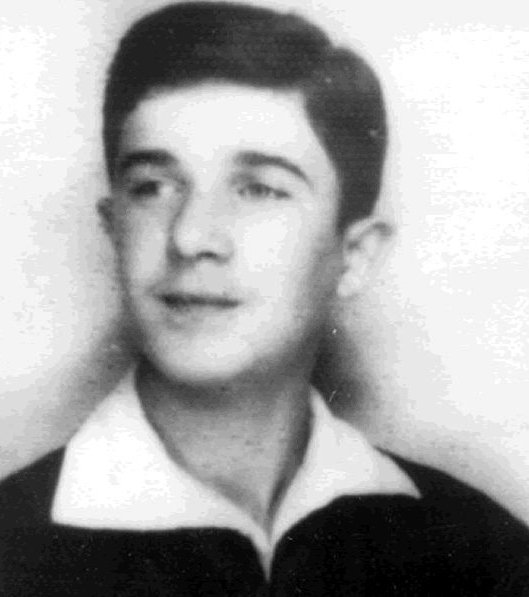
(Mordechaj Anielewicz, commander of the Jewish Fighting Organization)
The Jews of Warsaw had been so intent on their own survival during the Aktion that the implications of what was happening were almost lost on them. After the totality of what had happened began to sink in, feelings of depression, shame, survivors’ guilt, and rage consumed them. The men of the ŻOB and the ŻZW harnessed that rage and were intent on one thing: armed revolt.
The Poles
Polish-Jewish relations had become toxic in the years just preceding the German invasion. Fervent, traditional Catholicism and a belief that the Jews were behind the Bolshevik Revolution and the Soviet Army’s failed attempt to conquer Poland in 1920 led to a nasty strain of anti-Semitism in many quarters, particularly in the country’s rural east. Jewish shops were boycotted and attacked, Jews were set upon by youngsters. So called “ghetto benches” were set up in the lecture halls of Polish universities, in which Jews had to sit. After the German invasion, the Nazis did their best to increase the antagonism, by marking the Jews and isolating them, both physically and economically. While many Poles were horrified to see what was happening to the Jews, many others saw the Jews’ forced impoverishment as a bonanza: they were able to move into the Jews’ apartments, keep their property, and take over their businesses. Therefore, they had no incentive to help the Jews, which would mean a reversion to the status quo ante.
The Polish underground did report about what the Nazis were doing to the Jews, in detail – the ghettoization, the shootings, the deportations, the exterminations. The Polish government-in-exile in London was updated regularly. While the mainstream Polish underground and the Polish government condemned the atrocities in strong terms, they also made clear that their opposition was only rhetorical. There was nothing, they said, that they could do to stop the carnage. Generally speaking, the Polish government-in-exile did not want to highlight Jewish suffering too much, because it would, in their estimation, minimize the agonies of the Polish nation, which were shattering and enormous.
It seems unlikely that the Poles could not have blown up railway tracks or even attacked the death camps themselves if they had so chosen. The constant excuse was that the Polish underground had to husband its resources for a final confrontation with the Germans and could not spare them to save the Jews. The Polish underground and government were fearful that the Germans would move on to the non-Jewish Poles once they had finished with the Jews, so they had to prepare for this eventuality with all the force they could muster. The unspoken assumption, of course, was that the Jews, although Polish citizens, were not really Poles, and therefore were not worth full-throated, or any-throated, Polish resistance.
The Polish underground largely held the Jews in contempt, seeing them as going to their deaths like sheep to the slaughter. They did not, they said, want to waste arms on such people. So despite the repeated calls for help by Warsaw’s Jewish underground, the AK only provided a handful of revolvers, some of which were defective. The ŻZW, as mentioned above, fared a little better due to close personal ties with AK officers.
Many Poles, however, were profoundly distressed by what was happening to their Jewish neighbors. After the Aktion, the Polish government-in-exile set up the Council to Aid Jews (Polish: Rada Pomocy Żydom, code name Żegota), which helped thousands of Jews to survive through providing false documentation, food, medicine, and shelter. Every Jew who survived the war in Nazi-occupied Poland only did so through the help of non-Jewish Poles, who assisted Jews at risk to their own lives (and that of their families). But it must be said that the majority of Polish society was indifferent to the slaughter of the Jews, which was also the case in almost every society in Europe.
Revolt
Himmler ordered the liquidation of the Warsaw ghetto in October 1942. What he foresaw was the elimination of unregistered Jews and the gradual removal of war industries from Warsaw to the Lublin district, where the Jews would be worked to death or exterminated in Globocnik’s nearby death factories. When SS men marched into the ghetto on January 18, 1943, however, they were met with gunfire, grenades, and Molotov cocktails. The Germans, accustomed to a more obedient quarry, were stunned, although they still managed to deport more than 5,000 Jews to Treblinka (short of their goal of 8,000).
The sight of Jewish resistance was a source of elation for the resistance movements, and also a sign to the Polish underground that perhaps the Jews were worthy of their respect, and more importantly arms, after all. More weapons, at this point, flowed into the ghetto, albeit still on a meager scale. Assistance also came from the Gwardia Ludowa (People’s Guard, or GL), a communist underground movement. The Jewish rebels, knowing that the Germans were licking their wounds and would be preparing a major, final assault on the ghetto, began building hidden bunkers all throughout the ghetto – underground, in attics, behind false walls, etc. The general population was to ignore the German lies about “resettlement” and stay in the bunkers at all costs while the rebels did all they could to fight the Nazis.
The Germans entered the ghetto in the early morning hours of April 19, 1943, the eve of Passover, for the final liquidation. The Jews were to be either shipped to immediate death at Treblinka or a more gradual death in the camps of the Lublin district, including the infamous Majdanek. When the Nazis first entered, they were welcomed with quiet streets. More on their guard after their experience in January, they walked the streets cautiously. The Jewish fighters launched their initial attack on the corner of Zamenhof and Miła Streets, where today there stands a memorial to and mass grave of dozens of ghetto fighters. They fought the Nazis openly, in the streets, before deciding, after heavy casualties, to take full advantage of their knowledge of the city and their small quantity of both personnel and weapons by fighting a guerrilla war. Much to the fury of the Germans, and especially Himmler when he was informed, members of the ŻZW raised the Star of David and the red-and-white flag of Poland above their headquarters, which became the site of some of the most ferocious fighting of the revolt. Many of the Jews died with the word Polska on their lips while, devastatingly, the denizens of “Aryan” Warsaw looked on mostly in indifference, as captured in the magnificent poem “Campo dei Fiori” by the poet, and Warsaw resident, Czesław Miłosz.
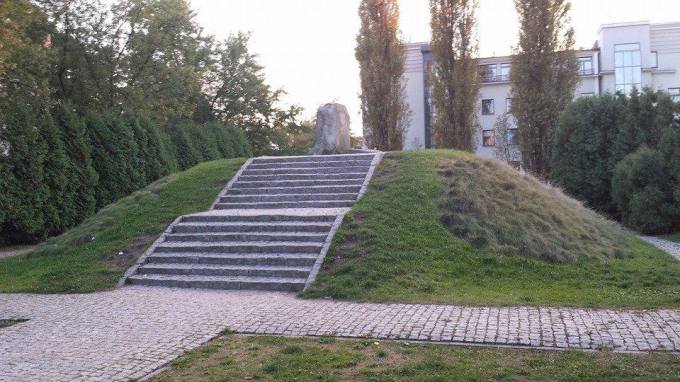
(The Anielewicz Mound in Warsaw. It is located on the intersection of Zamenhof and Miła Streets, where the first shots of the uprising were fired. It was also the site of Miła 18, the Jewish Fighting Organization’s headquarters. It contains the bodies of some of the ghetto fighters and rubble from the Warsaw ghetto. Photo taken by Jared Sorhaindo, September 2014)
The SS general tasked with putting down the uprising, Jürgen Stroop, decided to methodically destroy the ghetto, house by house, street by street. His troops used flamethrowers and toxic gas to either burn the Jews inside to death or to flush them out. According to his own notes, whole families jumped from the windows of buildings to escape the flames. In other instances, Stroop observed, the Jews decided to turn around and die in the fire, rather than give themselves up to the Nazis. It became increasingly embarrassing to the Germans that it was taking so long to squelch this Jewish rebellion – they felt the eyes of the Poles, particularly, and the world in general, judging and mocking them. No less a personage than Joseph Goebbels, the Nazi minister for propaganda, expressed a certain sense of admiration for the Jews in his diary:
There is nothing sensational in the reports from the Occupied Territories. The only thing noteworthy is exceptionally sharp fighting in Warsaw between our Police, and in part even the Wehrmacht, and the Jewish rebels. The Jews have actually succeeded in putting the ghetto in a condition to defend itself. Some very hard battles are taking place there, which have gone so far that the Jewish top leadership publishes daily military reports. Of course this jest will probably not last long. But it shows what one can expect of the Jews if they have arms.
The news of the uprising, needless to say, did not reach Goebbels’ typical audience in Germany.
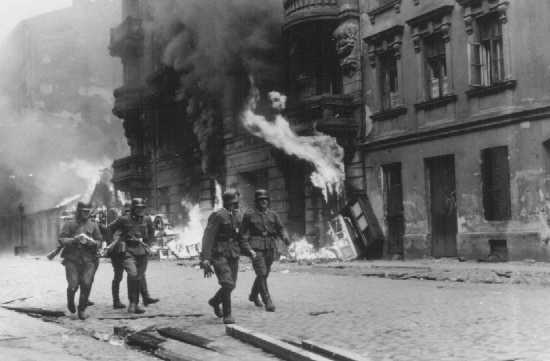
(The Warsaw ghetto in flames, 1943)
For the Jews, their resistance, while hopeless, was exhilarating. Anielewicz wrote in a letter to his deputy, Yitzhak Zuckerman, “The dream of my life has risen to become fact. Self-defense in the ghetto will have been a reality. Jewish armed resistance and revenge are facts. I have been a witness to the magnificent, heroic fighting of Jewish men in battle.” It should not go unmentioned that Jewish women also took part in the fighting, at times hiding grenades under their blouses until they were captured by German soldiers, at which time they would detonate and throw the explosives. Anielewicz, Wilner, and dozens of the ŻOB’s top command died when the Germans surrounded their headquarters at Miła 18 on May 8, opting to commit suicide rather than surrender to or be killed by the Germans. Stroop announced the end of the fighting on May 16 with the demolition of the Grand Synagogue and with the exclamation that gave the title to the report he prepared for Himmler: “The Jewish Quarter of Warsaw is no more!”
Stroop kept a daily tally of the Jews captured and killed in the course of the uprising. According to his tabulations, 7,000 Jews were killed in the ghetto itself; nearly 7,000 were deported to Treblinka; and the balance, about 42,000, were sent to labor camps in the Lublin district such as Poniatowa. Spooked by the specter of the uprising in the Warsaw ghetto, as well as revolts at Treblinka and Sobibór later that year, Himmler ordered the annihilation of the Jews in the Lublin district. 43,000, many of them from Warsaw, were murdered in a one-day massacre on November 4, 1943 in the Majdanek, Poniatowa, and Trawniki camps. One can still see today the jagged moonscape of the mass graves behind the crematorium at Majdanek.
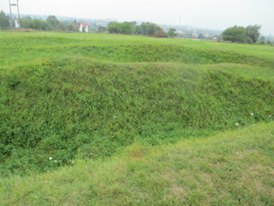
(The mass graves at Majdanek. Photo by Jared Sorhaindo, September 2014)
The Poles, for their part, had a varied response to the uprising. As noted above, many residents of Warsaw were shockingly casual about what was happening. Some even expressed pleasure: the Jews had it coming, and the Germans were doing a dirty, but necessary, job. Some anti-Semitic outlets stated categorically (and absurdly) that the Warsaw ghetto was the Soviet Union’s forward operating base on Polish soil and the uprising was being led by Soviet operatives who had parachuted in: therefore, it was to the good that the Germans were destroying it.
Other newspapers expressed admiration for the Jewish uprising and sympathy for the Jews. Myśl Państwowa called the Nazis’ brutality the “ultimate act of German bestiality” and declared that the Jews had “demonstrated their right to national existence.” The newspaper Polska Walczy bluntly stated that “every echo that reaches us from the burning ghetto racks our consciences and grieves us… It is a battle of the hopeless against a berserk beast of prey.” For his part, Polish Prime Minister Władysław Sikorski called the Germans’ crushing of the uprising “the greatest crime in human history.”
At times, admiration for the Jews was couched in contempt for what the Poles perceived to be Jewish passivity and cowardice, so unlike what they saw as the martial virtues of the Polish nation: “This is probably their first show of revenge since the days of Bar Kochba,” Nowa Polska, an underground newspaper, opined. “The last time the Jews fought was 1800 years ago… Who knows whether the spirit of Israel will not rise out of the ashes of Warsaw?” rhetorically asked Prawda Młodych, a traditionalist Catholic and anti-Semitic organ.
During the fighting itself, the AK and the GL made some, albeit limited, attempts to assist the Jewish fighters, including an unsuccessful effort to breach the ghetto walls and engaging German soldiers on the “Aryan” side of the city.
Reflections
The first thing I felt upon setting foot in what had been the Warsaw ghetto was a sense of awe. To stand in this place of mass suffering and death, and also heroism, was a lot to absorb – too much, in fact, as awe gave way to a sense of disbelief. The sheer enormity of what had happened here – both the evil and the nobility – made the event hard to grapple with, made it seem like it had happened ages and ages ago, like it had come from the pen of a Tennyson or a Milton, or from the Bible itself.
Everywhere I looked was once filled with teeming masses of Jews leading miserable existences, often starving to death on the streets, and yet striving to live a life with meaning despite it all. Here was once a wooden bridge to prevent Jews from “tainting” an “Aryan” Polish street below; impoverished peddlers hawking their pathetic wares; young men and women sunbathing to escape reality for a while; parents teaching their children the very concepts of forests, fields, rivers, and mountains, which were beyond the imaginations of the imprisoned children, even though the mighty Vistula flowed not even a mile away; SS men laughingly cutting off the beards of pious men or setting them alight; men and women trudging off to perform labor to sustain the military machine of the nation that was destroying their people. And then the scenes of destruction: the clatter of boots on pavement; the shootings; the barking dogs; the forced processions to the Umschlagplatz; the women, children, and the elderly dying of thirst in the sweltering summer heat; the trains being stuffed with their human cargo. And finally, the crescendo: the sounds and smells of combat; the cursing of Nazis by Jews and of Jews by Nazis; the explosions and gun battles; the fire; the coughing of the gassed; the demolition of the Grand Synagogue.
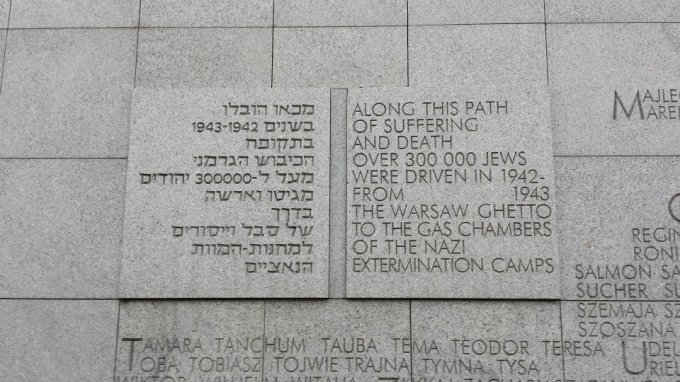
(Umschlagplatz memorial, Warsaw. Photo by Jared Sorhaindo, September 2014)
These thoughts and more swirled through my head and ultimately paralyzed my imagination: I just could not process where I was standing and what scenes this place had witnessed. I sat on a park bench near the Monument to the Ghetto Heroes, which stands on a plaza surrounded by four streets, one of them now named Anielewicz Street (and formerly the site of a concentration camp that the Nazis established on the ruins of the ghetto) and smoked cigarette after cigarette in the drizzling rain. I sat and I sat, but as much as I tried, I could not think, or, to the extent that I could, it was as though I were conjuring up half-remembered images from an old film. “The Warsaw ghetto,” I thought, its very name sending goosebumps up my arms; but when I looked around, I could not connect the pictures and facts in my head with what I was seeing before me. I could name the names and the dates, but I couldn’t square them with the fact that it had happened here, where I sat.
While my mind could not bridge the gaps between historical knowledge and physical presence, and never really did, my feelings, at first numbed in the same way, did give way on one occasion. I recall wandering from the Monument to the Ghetto Heroes and having a few drinks at a bar while still failing to process my experience. I walked back to my hostel, slightly buzzed, and found myself approaching Warsaw’s beautiful National Theater. I saw the flags of several nations fluttering in the breeze, one of which was the flag of Israel. I recalled the raising of the Polish and the Jewish flags in the early stages of the uprising, and the heroism of the fighters, and was struck by a powerful wave of emotion. I continued the walk back to the hostel with my vision clouded by my tears – perhaps too clouded, because I became hopelessly lost and wound up having to speak pidgin German (at the time I could not even eke out a dzień dobry) in a pathetic attempt to find Nowy Świat Street. It was simply overwhelming.
The Jewish fighters of the Warsaw ghetto only killed a relative handful of German soldiers and the vast majority of them were killed outright or died later. But that was not the point. The Jews of the Warsaw ghetto did not fight to win, or even to live. They fought for their dignity, to avenge their loved ones, and to be remembered.
 Jared Sorhaindo, Washington D.C., May 8, 2017
Jared Sorhaindo, Washington D.C., May 8, 2017
You must be logged in to post a comment.